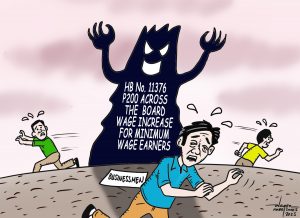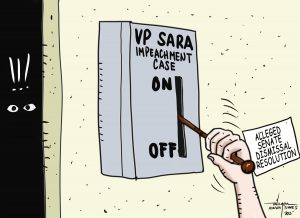By Soliman M. Santos, Jr.
NAGA CITY (MindaNews)— Overdue more than nine months after the breakthrough Oslo Joint Statement of 23 November 2023 between the Government of the Republic of the Philippines (GRP) and the National Democratic Front of the Philippines (NDFP) [led by the Communist Party of the Philippines (CPP) and New People’s Army (NPA)] where they, among others, “agree[d] to come up with a framework that sets the priorities for the peace negotiation with the aim of achieving the relevant socioeconomic and political reforms towards a just and lasting peace… that will set the parameters for the final peace agreement,” both sides have confirmed at least “ongoing talks” to come up with that framework. Presidential peace adviser Secretary Carlito Galvez, Jr. said “exploratory talks are ongoing.” The process, according to him, is to first come up with vision (or mission) statement, then working on a framework agreement that would become the basis for a final peace agreement.
The breakthrough Oslo Joint Statement actually already has certain elements for that vision-mission and even framework, namely:
– “a principled and peaceful resolution of the armed conflict. Resolving the roots of the armed conflict and ending the armed struggle shall pave the way for the transformation of the CPP-NPA-NDFP.”
– “the need to unite as a nation in order to urgently address these challenges (the serious socioeconomic and environmental issues, and the foreign security threats) and resolve the reasons for the armed conflict… envision and look forward to a country where a united people can live in peace and prosperity”
Despite this breakthrough and some indicated basis of unity, there are “mixed (or crossed) signals” from both sides, not just government, on resuming peace talks. National Security Adviser Secretary Eduardo Año, for one, reportedly does not see that happening soon because of lingering misunderstandings and disagreements. In particular, he points to the CPP-NPA-NDFP as “can’t resolve… to renounce the armed struggle,” without which “nothing will come out of any talks just like in previous negotiations.” This refers to the known and documented CPP-NPA-NDFP policy and practice of tactical use of such negotiations in support of its overarching strategy of protracted people’s war with armed struggle as the main form of struggle, the line of march reaffirmed again in a yet third rectification movement. As it is, the parties would not even be able to agree whether what they are resolving is a non-international armed conflict (GRP) or a “civil war” (NDFP).
In “condemn[ing] this militaristic approach of Año,” the NPA-Northern Negros Command stated that “Peace talks is [sic] conducted to address the root cause of armed conflict… With the leadership of the CPP in waging revolution, the NPA will continue to build and strengthen the mass base, address the land and economic issue through agrarian revolution, and conduct tactical offensives as part of the armed struggle, whether the NDFP-GRP is engaging in peace talks or not… For revolutionary NPA, to give up armed struggle is to give up the masses aspiration of economic stability, social justice and long-lasting peace. With that, the revolution lives on.” The impression given here is that the CPP, NPA and NDFP have separate roles of revolutionary leadership, armed struggle and peace talks, respectively, but actually these are all coordinated by the CPP which calls the shots in the battlefield and in the negotiating table.
Since the Oslo Joint Statement, CPP-NPA-NDFP statements have emphasized the passages on “(a principled…) Resolving the roots (and reasons) of the armed conflict,” while GRP statements have emphasized the passages on “peaceful resolution of the armed conflict… ending the armed struggle… pave the way for the transformation of the CPP-NPA-NDFP.” Both aspects of principled resolving of the root causes and peacefully ending the armed conflict/ struggle should be better addressed in a balanced, simultaneous and calibrated way. It is or may be too early for the GRP to call on the CPP-NPA-NDFP to renounce armed struggle without sufficient progress in addressing the roots of the armed conflict, “whether the NDFP-GRP is engaging in peace talks or not.” Indeed, those root causes can and should also be addressed outside the ongoing talks. But it is also counter-productive and wasteful of precious lives to continue armed hostilities while still in the process of (what should be) sincerely and seriously addressing the root causes, for whatever it may be worth (not just propaganda), through peace negotiations.
If the goal or vision is “a principled and peaceful resolution of the armed conflict” and there is “the need to unite as a nation in order to urgently address these challenges and resolve the reasons for the armed conflict,” then why still kill each other and innocent civilians caught in your crossfire? Silencing the guns (ceasefire), not necessarily laying down arms (surrender), while giving honest-to-goodness peace talks a fair chance within a reasonable time frame, and with “a favorable climate,” to address the root causes, is the reasonable and sensible thing to do. Sincerity has to be proven in concrete deeds and measures by both sides in order to build the necessary mutual trust, “goodwill and confidence.”
The problem blocking even that initial way of peace at this point is that both sides are more concerned in the short-term with their respective military efforts, gains, or regaining ground on the war front. In the long or strategic term and view, when it comes to addressing the root causes—like the CPP-NPA-NDFP’s avowed “key issues of agrarian reform and national industrialization”—it looks “unlikely” to be satisfactorily resolved between the irresistible force of the CPP 2016 Constitution and Program for a People’s Democratic Revolution (PPDR) and the immovable object of the 1987 Philippine Constitution. It appears that this contention is more about political power and governing sovereignty rather than the substantive reform agenda. The unfortunate logic of this reality is a resolution in the military arena unless there can somehow still be a war and peace paradigm shift on both sides. It could depend crucially on the leaderships of both sides, their political will to shift to a peace rather than war strategy as the main direction, and their creativity in dealing with the fundamental guiding documents and parameters of their respective sides. If it is any source of hope at all despite the different contexts, that precisely was what worked out in the successive peace negotiations between the GRP and the two main Moro liberation fronts.
SOLIMAN M. SANTOS, JR. is a retired RTC Judge of Naga City; a long-time human rights and international humanitarian lawyer; legislative consultant and legal scholar; peace advocate, researcher and writer on both the Communist and Moro fronts of war and peace; author of a number of books, including How do you solve a problem like the GRP-NDFP peace process? Part 2 (Sulong Peace, 2022) and the recently released TIGAON 1969: Untold Stories of the CPP-NPA, KM and SDK (Ateneo Press, 2023).




